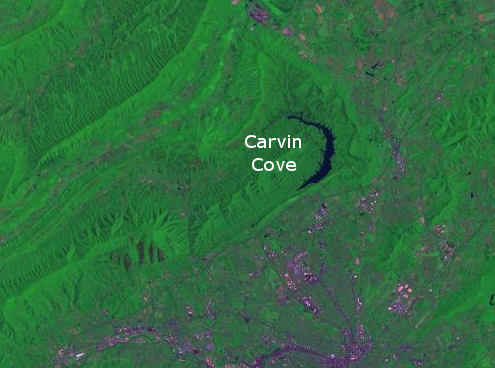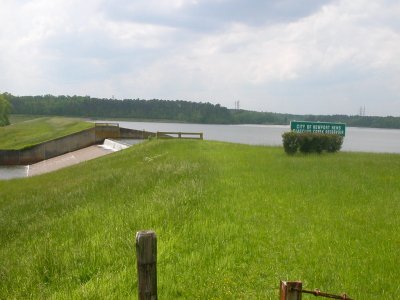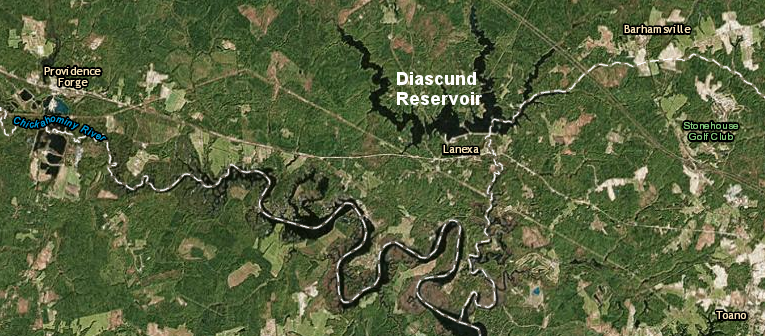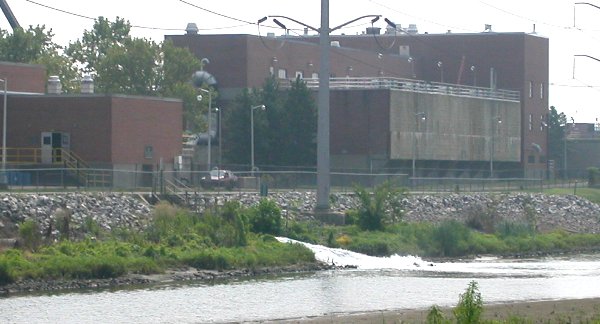
Carvins Cove - drinking water reservoir for City of Roanoke
(protected site, with no soil-disturbing development and limited recreation opportunities)
After Las Vegas sewage is processed in its wastewater treatment plant, it flows through a pipe and down a desert wash into the Colorado River - specifically, into Lake Mead behind Hoover Dam. Six miles downstream, another pipe sucks up water from Lake Mead and carries it to a water treatment plant, where it is chlorinated and then piped throughout Las Vegas as drinking water.
Yes, unless you get your water from a well, you too are probably drinking recycled sewage. We all live downstream... and in many cases, the folks who live upstream dump their wastewater into the river from which we extract our drinking water.
Much of Fairfax County gets its water from the Occoquan Reservoir. The Upper Occoquan Sewer Authority wastewater treatment plant dumps processed sewage into the Occoquan River just upstream of Route 28, near Manassas. It replaced 11 secondary wastewater treatment plants in 1978, and is recognized internationally as a successful operation. Roughly half of the water flowing into the Occoquan Reservoir is "product" from that plant now. If you swim in the Occoquan River, or walk along Bull Run near GMU's Hemlock Overlook outdoor education center... half of that water came from the sewage treatment plant.
The "intake" pipe for the water treatment plant located just upstream of where Route 123 crosses the river at the small town of Occoquan. If you drive on Route 123 to the Fairfax campus of GMU, you can see on the west side of the road the Griffith Water Treatment Plant. It was built on the grounds of the old women's prison at Lorton, where the women arrested in the 1917 White House protests over suffrage were jailed. The prison is being replaced by the "Laurel Hill" development.

Carvins Cove - drinking water reservoir for City of Roanoke
(protected site, with no soil-disturbing development and limited recreation opportunities)
Some communities have been able to locate reservoirs in places where there is minimal development upstream. Carvins Cove (a major reservoir supplying Roanoke) and Diascund Reservoir (supplying Newport News) are two such examples.
Other communities are unable to establish a "headwaters" reservoir where pollution flowing into the water supply can be minimized. Instead, the downstream communities depend upon modern technology to clean the water that arrives at their doorstep - and on pollution control regulations, to limit the chemicals and other forms of pollution that might be dumped into Virginia's waterways and thus need to be removed at the water treatment plant.

Diascund Reservoir dam

the Diascund Reservoir was created by damming a tributary of the Chickahominy River
Source: ESRI, ArcGIS Online
The residents of Richmond get their drinking water from the James River, far downstream from where it originates on the western border of Virginia. If you drink that water, be aware that the sewage from Charlottesville, Lynchburg, Covington, and many other communities was dumped into the James River - after being cleaned in a wastewater treatment plant.
The town of Abingdon upgraded its wastewater treatment plant in 2008, and the people drinking water provided by the city of Bristol will benefit from cleaner water flowing into South Holston Lake. Abingdon was proud that its new facility removed nitrogen... but wastewater treatment does not remove everything.
All waste outflows show evidence of the pharmaceuticals that were swallowed by people as medicine, then excreted and flushed. Fish in the Shenandoah and Potomac rivers are developing both male and female sex organs. That abnormal physical change may be triggered by chemical residue from birth control pills and other drugs that were excreted by humans and flushed, but not destroyed in the treatment process at the wastewater treatment plant downstream of the toilet.

Treated sewage pouring from Arlington County Wastewater Treatment Plant
into Four Mile Run near Reagan Washington National Airport